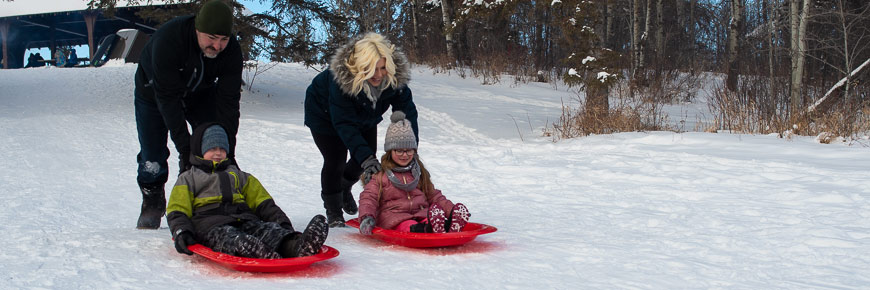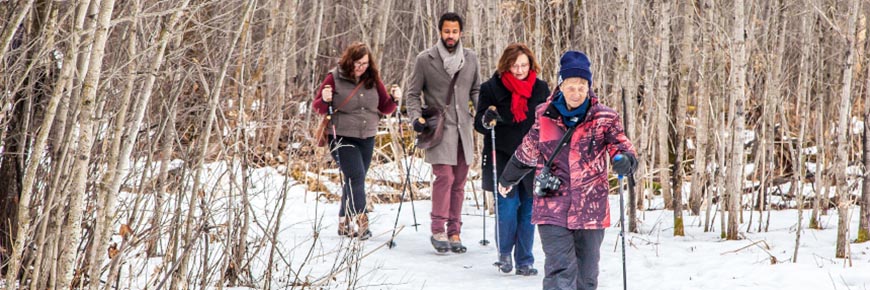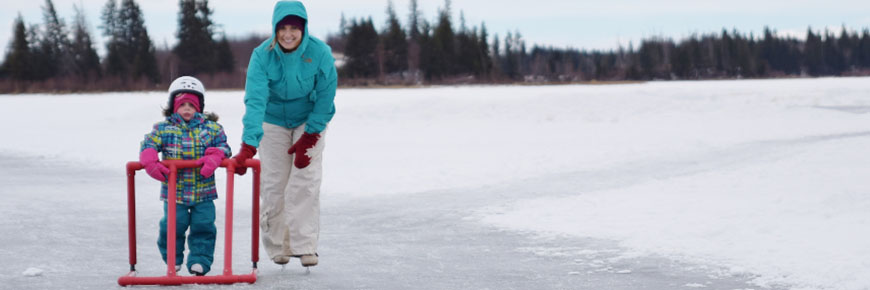
Winter safety
Elk Island National Park
Thin ice may exist anywhere on water bodies, at any time, in the winter season. Assess ice thickness and never go onto ice alone. The Canadian Red Cross recommends an ice thickness of at least 15 cm for walking and skating safely; the thicker the ice, the better.
Exploring Elk Island National Park in the winter is an excellent way to discover the park and its inhabitants. Wildlife is often easier to spot without the leaves on the trees and there is clear evidence of creatures big and small thanks to tracks left in the snow.
When visiting during the winter be aware of the extra hazards such as cold temperatures, storms, challenging travel conditions, and short daylight hours. To make each visit to this winter wonderland a safe and enjoyable one, be sure to check the forecast and prepare for the weather before departure. This includes filing a trip plan with a trusted adult and bringing essential items, like water and a head lamp.
Driving
Alberta weather can affect road and travel conditions, particularly during the winter months. Before leaving, check the forecast and road conditions using Alberta 511.
At Elk Island National Park, one can always count on there being snow in the winter. Pack supplies to prepare for an emergency and come with a full tank of gas as there is no gas station at Elk Island National Park.
When winter driving conditions exist on the parkway and park roadways. Slow down and be aware of surroundings. File a trip plan with a trusted adult. Roads are not regularly patrolled in the park and Parks Canada does not offer towing services.
Observe posted speed limits and watch for wildlife on or near the roadway. Be aware of wildlife on roadways especially at dawn and dusk when animals are most active and low light can make them difficult to see. Large animals such as bison, bears and elk with dark colouring can blend into the landscape in low light.
Pay special attention when driving at night as wildlife are often challenging to see, even with headlights on.
No matter what the weather, follows these tips when driving through Elk Island National Park.
Hiking, skiing and snowshoeing

Winter can be an excellent time to explore and experience the serene wilderness of Elk Island National Park. Trails are often well-packed by the many snowshoers and hikers. Trails are multi-use and are not groomed for skiing. Exercise caution and watch for icy sections, deep snow and fallen trees. Use ice cleats and hiking poles to prevent slips and falls.
Weather can change quickly. Plan for the weather and watch for changes in weather conditions.
Use caution when hiking, skiing or snowshoeing on lakes or ponds. Areas of thin ice exist on water bodies throughout the park.
Children need constant supervision. Keep children within arm's reach on and around ice.
Kite boarding
Astotin Lake offers excellent conditions for kite boarding.
Wind conditions can change quickly. Periods of extreme wind or the loss of wind are common. Be prepared to walk back to the parking lot if the wind dies down.
Skating

Ready for a unique way to soak in winter’s enchantment with your loved ones this winter? Add skating to your winter bucket list! Bundle up, pack a thermos and head out to the Astotin Lake Area in Elk Island National Park.
Alberta weather can change quickly. Plan for the weather and be aware of changes in weather conditions.
Keep children within arm's reach on and around ice.
Thin ice may exist anywhere on water bodies, at any time, in the winter season. Assess ice thickness and never go onto ice alone. The Canadian Red Cross recommends an ice thickness of at least 15 cm for walking and skating safely; the thicker the ice, the better.
Emergencies:
- Call Parks Canada Dispatch 1-877-852-3100 for incidents involving wildlife, campground disturbances, wildfire, poaching or search & rescue. Response times may vary
- In case of an emergency, call 911
- Hospitals are located in Lamont, Sherwood Park and Fort Saskatchewan
In the event someone breaks through the ice, follow the Canadian Red Cross recommendations for group and self-rescue techniques. Hypothermia happens very quickly. Watch for symptoms including shivering, confusion, slurred speech, drowsiness, low energy. Go indoors and change into warm, dry clothing.
- Date modified :